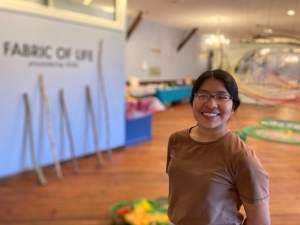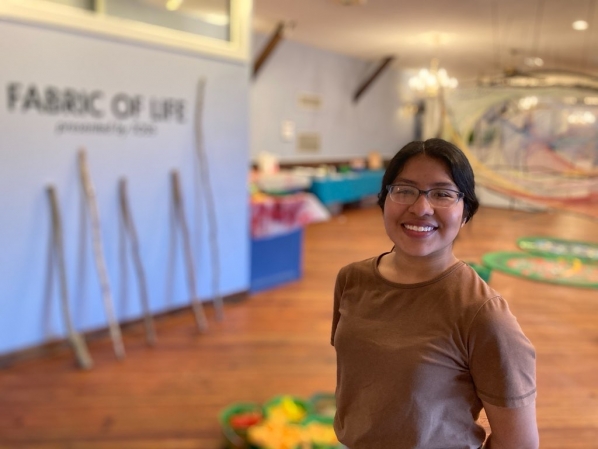Alisa Cruz-Mendez, an intern of TOSS, is a STEAM advocate based in Morganton, NC. Alisa is a senior at Freedom High School, graduating with honors, and attending college in the fall. As a resident mathematician at TOSS, Alisa has increased the interdisciplinary practice of math and art and taught us all what it means to work tirelessly to execute a beautiful work of art. Alisa enjoys spending time with her dog, playing soccer, and running during her free time.
Tell me more about the Fabric of Life arts festival and your piece in it?
I was invited by Kathryn to present a project for the public school students of Florence County. Every year Kathryn is invited by Artfields, an annual festival in Lake City, South Carolina, to create an interactive art piece for students. Artfields strives to revitalize a small town into a gallery where art is easily accessible and Southern artists are celebrated (https://www.artfieldssc.org/). As an intern at TOSS and as a STEAM advocate, Kathryn thought it would be a great opportunity for me to create an installation that would allow me to display my knowledge of science and math while allowing me to explore art.
Is it a solo piece or a group project? Where did the inspiration for it come from?
I did most, if not all, of the work. I designed the installation with occasional assistance from Kathryn and executed the project all by myself. Kathryn really wanted to give me ownership and for me to be my own boss with this project so I could gain decision-making and critical thinking skills. I researched for weeks before curating an idea or design. The project criteria were very broad so the options were limitless, but it also made it difficult for me to design something that was eye-catching, included a math/science component, and at a large scale. I had primarily taken the science route and discovered a notable figure in biology, Henrietta Lacks, who embodied the unethical procedures that were performed on African Americans by scientists in the early 1900s. While the idea did fit the criteria for the installation and matched TOSS’s values of racial equity, there was no clear way to translate Henrietta's story into art. I then turned to the math route where I was able to rediscover concepts that I had learned last year during my time at the NC Governor’s School. I was ecstatic when I was able to connect my previous experiences to a project of this scale. After timeless research, I was able to dive deeper into topology - a branch of mathematics that discovers geometric shapes and how they can be deformed in space and different dimensions. I was able to pick our 2 mathematical concepts from topology - knot theory and fractals. I was then able to use the 4-color theorem when deciding the color palette for the yarn in the installation. This was probably the hardest part since I was limited to the colors and amount of yarn I had because we did not want to purchase any additional yarn since we already had an abundance at the studio. Yet, this was crucial because TOSS wanted to also emphasize its value in environmental sustainability.
Tell me about your interest in art? When did that start? What is your favorite thing to create?
It seems like a paradox for me to be working at an art studio and creating a large art piece. I never had access to an arts education growing up since my parents did not see the value in it. Naturally, I never took it upon myself to take an art class in middle or high school. Yet even with my lack of an education in the arts, I was still able to create something beautiful. This was an exciting opportunity for me and for TOSS especially because we have a large emphasis on providing all students with an arts education regardless if they are interested in an arts-related career or not. TOSS realizes the value of art education as it allows students to begin thinking creatively and critically which is crucial in all facets of life.
I would say the closest thing to art-making that I like to create is writing. I find it difficult to voice everything I want to say and feel, but writing has helped me think carefully and reflect on myself. During this time of solitude that I have with writing, I have created a deep and intimate relationship with myself.
What are your future plans? Have you decided on a college and what do you want to study?
I have not officially decided where I want to attend college, but I will either be going to UNC-Chapel Hill or Duke University. I will be making this decision very soon so I can give you an update when I decide if that is helpful information. I am also not very sure of what I want to study but I want to go into the social sciences route and I am considering either Interdisciplinary Studies, Medical/Evolutionary Anthropology, or Public Policy.
Fabric of Life will provide students with a fun, interactive way of creating to connect. Through this project, students should be able to identify themselves as an important component of the collective health and well-being of Florence County. Fabric of Life will consist of a large installation of yarn and textile fibers that will create an opportunity for students to walk through a landscape of art guided by a map. The map will lead them to an activity table near the corner of the room where they can work on a 10-20 minute activity to take home.
Make & Take Activity
Students will create a landscape with yarn, fabric, and other textile materials. Students will utilize yarn (just as the installation does) to create a picture of Florence County (images will be provided for inspiration). In accordance with our theme, Fabric of Life, each thread in the landscape is representative of each community member in Florence - each contributing in a unique way to community unity and prosperity.
STEAM Connection
An underlying purpose of the installation is for students to understand and easily visualize different mathematical concepts (four-color theorem, fractals, and knot theory) through our 3-dimensional, interactive sculpture. Students will have age-appropriate info about the mathematical concepts embedded in their maps. Connecting the disciplines of art and math in a meaningful way is critical to breaking down sociopolitical and historic disparities dictating who participates in certain disciplines which communities benefit as a result.
About TOSS
Based in Morganton, NC, TOSS is an advocacy studio of The Industrial Commons. Our mission is to educate our community around the future of work, environmental sustainability, and racial justice. Harnessing the power of art and community organizing, we work toward personal and institutional transformation for and with working-class families. Learn more at tosstudio.org.
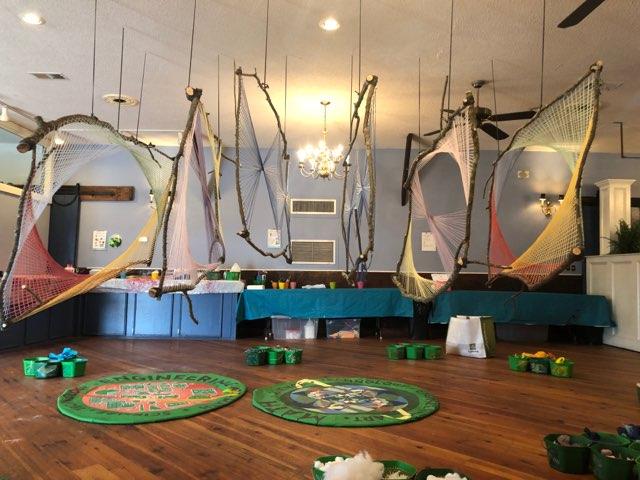
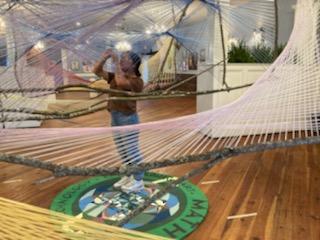
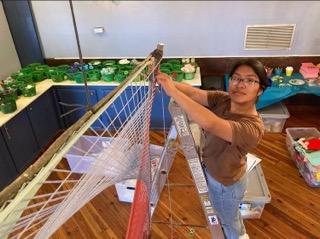
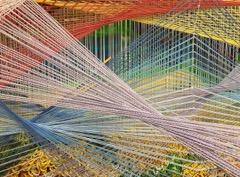

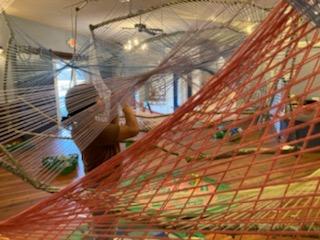
This was an exciting opportunity for me and for TOSS especially because we have a large emphasis on providing all students with an arts education regardless if they are interested in an arts-related career or not. TOSS realizes the value of art education as it allows students to begin thinking creatively and critically which is crucial in all facets of life.
